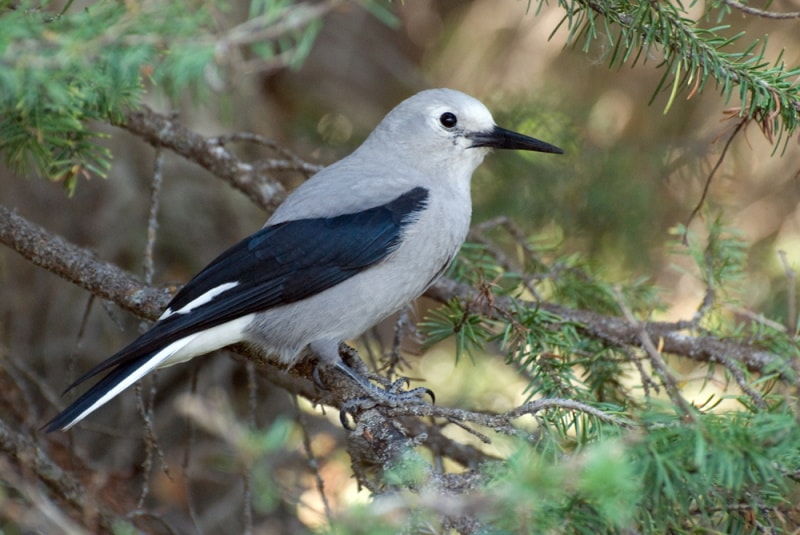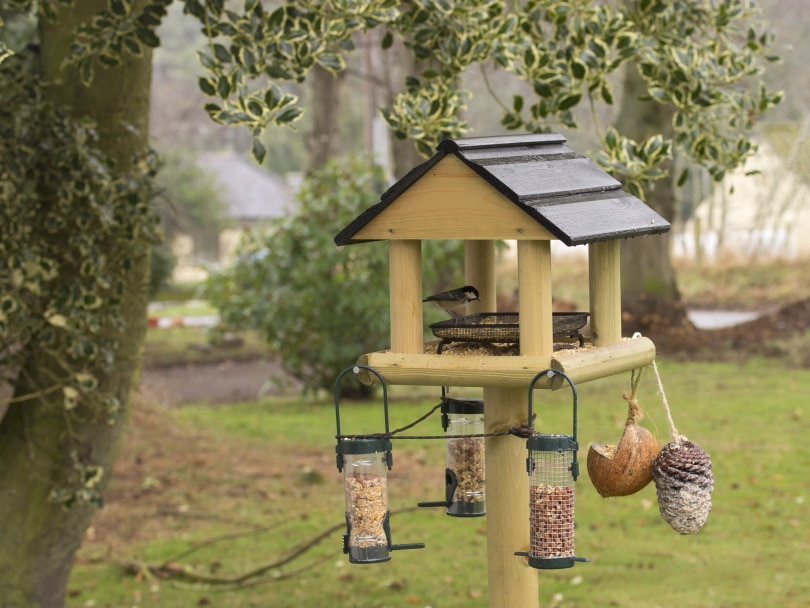Clark’s Nutcracker: Field Guide, Pictures, Habitat & Info
Last Updated on

Clark’s Nutcrackers are the resident birds of the mountains. They reside in pine trees that produce large seeds and montane evergreen forests in the West. These compact-sized birds prefer nesting on trees 3,000–11,000 feet high.
If you live anywhere between the West mountains of the US and Ontario, you’re likely to see gray-and-black jay-sized birds flying in flocks. Clark’s Nutcrackers are omnivores. They can eat plants and multiple insects, making them highly adaptable to different environments.
Let’s explore Clark’s Nutcracker’s habitat, range, diet, and how you can identify these birds quickly.

Quick Facts about Clark’s Nutcrackers
| Habitat | Forests |
| Diet | Omnivore |
| Behavior | Foliage gleaner |
| Nesting | Tree |
| Conservation | Low concern |
| Scientific name | Nucifraga columbiana |
| Lifespan | 17 years |
Clark’s Nutcracker: General Description
Clark’s Nutcrackers are the birds of the West mountains. They are gray-and-black small birds flying among high pine trees. You can identify them with their flashing white tail and wings.
These birds also have unique bills similar to daggers, which help them rip the pine cones and take out large seeds. They use their bills to stash these seeds underneath their tongues, holding them to bury for severe cold days.
Each Clark’s Nutcrackers can carry thousands of seeds every summer and hide them in known locations. The seeds they don’t pick turn into new pine trees. These birds are mostly migratory, traveling a vast range every year to as far as central Ontario.

Clark’s Nutcracker: Range, Habitat, Behavior, Diet & Nesting
Clark’s Nutcrackers are interesting birds with diverse diets and unique behavior. Here is everything you must know about these birds to spot them quickly:
Range
Clark’s Nutcrackers are altitudinal migrant birds. Their eggs usually cracker in late spring. During this time, these birds fly upslope to subalpine areas of whitebark and limber pine.
When spring ends and fall arrives, Clark’s Nutcrackers move back to the downslope. They migrate downwards when the limber and whitebark pines show poor cone crops.
Many birds move longer distances when cones are scarce, even outside their usual range. Typically, their range can extend to as far as central Ontario and Pennsylvania.
Habitat
Clark’s Nutcrackers prefer nesting in open coniferous forests of the West US and Southwest Canada. They usually live high on the trees, approximately 3,000–12,000 feet.
In the summer, particularly early June, these birds become more abundant at higher altitudes near shrubby whitebark or lumber pine. These areas could also be mixed with spruce, pines, and fir. They also like nesting near creeks, lakes, and meadows.
When fall arrives, Nutcrackers move to lower elevations into limber pine, pinyon-juniper, Jeffrey pine, bristlecone pine, southwestern white pine, and ponderosa pine. They prioritize the forests with the highest number of seeds.

Behavior
Clark’s Nutcrackers prefer traveling in small flocks with back-and-forth calls. These birds often act like woodpeckers during the flight from one tree to another. They flap and hold their wings near their respective sides.
In the summer, Clark’s Nutcrackers spend most of their time collecting pine seeds and burying them in their pouches. They then use these seeds in winter for their family’s nourishment.
When gathering seeds, nutcrackers give each other a tough fight. These birds target those harvesting stored seeds and push them to snatch their seeds.
When it comes to mating, Clark’s Nutcrackers are monogamous. This means they prefer living with one partner for several years. Partners fly together with fast swoops and dives. Both males and females feed each other and collect twigs to make nests.
Clark’s Nutcracker pairs also protect their nesting territories with the help of their solid bills and claws. These birds start nesting in January and February, so their young will learn to fly in the late spring.
Nutcrackers mostly stay in groups except when they are collecting seeds. They also forage with other birds and animals, including Red-tailed Hawks, Swainson’s Hawks, Cooper’s Hawks, Great Horned Owls, and Golden Eagles.
Clark’s Nutcrackers seem to provoke and chase small raptors.
Diet
Clark’s Nutcrackers eat stored or fresh pine seeds throughout the year. They use their long, strong, and sharp bills to penetrate the closed and unripe pine cones. These birds crack open the cones and remove seeds from the scales by holding the cone between their feet and hammering it.
Nutcrackers store seeds between September and December to use later in the winter. They carry around 30–150 seeds in the pouch under the tongue and take them to a considerable distance of about 15 miles away. They bury the seeds underneath the ground.

During the winter and spring, Clark’s Nutcrackers relocate these seeds by finding nearby landmarks, such as trees, rocks, and logs. Their good memory helps them remember the location of seeds for about six to nine months.
Many of these buried seeds are left uncovered, turning into high-elevation pines. The Nutcrackers use the remaining cached seeds to feed themselves and their babies.
These birds also eat spiders, insects, and small vertebrates like squirrels, toads, chipmunks, carrion, and voles.
Nesting
The nests of Clark’s Nutcracker are located on the outer branches of conifer forests. These include junipers, pines, spruces, larches, and firs, near the places where they store seeds in the fall.
These birds prefer the leeward side of these trees to stay safe from the wind, but they are often poorly protected. It’s believed that both males and females play their roles in building nests. They gather twigs from Douglas-fir, incense cedar, and juniper to build nests in 5–8 days.
The male looks after the perch and the female connects twigs into the platform 8–13 inches on small branches.
The final shape of the Nutcracker’s nest is like a cup about 3 inches deep and 4 inches across. It is made of rotten wood pulp, dried grass, moss, strips of bark, and animal hair.
How to Find the Clark’s Nutcracker: Birdwatching Tips
It’s quite easy to spot Clark’s Nutcrackers on your next trip to the Western mountains in the USA. They are widely spread in nearby regions since they are known to migrate to significant distances.
If you’re an avid birdwatcher, keep these things in mind the next time you visit forests in the West.

What to Listen For
The easiest way to find Clark’s Nutcrackers is by listening to the long, grating calls they frequently make. Since these birds usually travel in small flocks, you’ll likely hear a loud call whenever they pass by.
What to Look For
Clark’s Nutcrackers don’t always give their unique calls. So, you may find it hard to identify these birds passing by. If you can’t hear any such calls in the Western mountains, watch out for these identification signs:
- Size and Shape. Clark’s Nutcrackers are jay-sized birds with the shape of a crow. They have small tails and round heads with no crest. Their bills are long, sharp, and straight.
- These birds have a pale gray color with black wings. When flying, their wings show multiple large white patches near the edges. The tail is mostly black from the center. The legs, bills, and feet of these birds are all black.
- Nutcrackers fly in small groups and crack the pine cones with sharp bills. They primarily eat pine seeds and fly with their long and broad wings. They mostly live in the mountains of the West, high above on the trees of the conifer forests.
When to Look
Clark’s Nutcrackers migrate to downslopes during fall when there is a poor pine crop or scarcity of pines. They also travel longer distances during this time. So, if you’re traveling to the Western mountains of the US, try going around in summer or spring to spot these birds.
Since they live at high elevations, don’t forget to take your binoculars to find them.

Attracting Clark’s Nutcrackers to Your Backyard: Tips & Tricks
Clark’s nutcrackers make the best backyard birds out there. They prefer living in trees with high elevations, so make sure your backyard has many trees to attract these birds.
Here are some effective tips for inviting Clark’s Nutcrackers to your backyard:
- Install Bird Feeders. Although Clark’s Nutcrackers prefer pine cones and seeds, they also feed on insects and other birds. They are omnivores, so you can install different types of bird feeders in your backyard consisting of Nutcracker’s favorite food items.
- Put Feeders in the Appropriate Places. Always place feeders appropriately to avoid predators or other birds reaching them before Clark’s Nutcrackers. These birds typically live on trees at some elevations, so ensure your feeders are placed accordingly.
- Use the Bird’s Favorite Food Items. Most Clark’s Nutcrackers eat insects, seeds, spiders, squirrels, and other birds. Fill the feeder with these food items to increase the chances of these birds coming to your backyard.
- Clean the Feeders. Birds generally eat fresh and hygienic foods. Keep the feeders nice and clean to attract Nutcrackers away from their natural habitat.
- Install a Birdbath. Bird baths offer free and clean water to Clark’s Nutcrackers to drink or bathe. These birds can cool off in summer and take a heated bath in winter to restore their energy.
These tips may give you the desired results but inviting Clark’s Nutcrackers to your backyard is pretty challenging. That’s because these birds are not ground foragers and prefer living on some elevation.

Clark’s Nutcracker Conservation: Is this Bird Threatened?
The North American Breeding Bird Survey reported that Clark’s Nutcrackers populations declined between the years 1966 to 2015. This trend was widely observed in Washington.
Partners in Flight estimated the global population of Nutcrackers to be around 230,000, with 11% living in Canada and the remaining 89% in the USA. The Continental Concern Score rates this bird species an 11 out of 20. Unfortunately, you won’t find Clark’s Nutcrackers on the State of North America’s Birds’ Watch List 2016.
The main reason for their local decline is primarily due to the epidemic of pine beetles and the rise of white pine blisters. Both of these things killed the whitebark pines that make up most of the shelter and diet of Nutcrackers.
Limber pines, pinyon pines, and southwestern white pines also faced similar dangers. Another factor is their vulnerability to climate change. Since these birds live on mountaintops, they are more likely to get affected by extreme temperatures.
On average, Clark’s Nutcrackers are low-concerned birds in the US and Canada.

Final Thoughts
Clark’s Nutcrackers are the residents of the western mountains of the US and Canada. These birds are identified by their long, sharp bills, short tails, and compact bodies. They give a loud call when traveling in small flocks.
The unique thing about these birds is their ability to stock up on pine seeds for winter. They crack open pine cones in the fall, carry the seeds in the pouch present under their tongues, and hide them underground. Nutcrackers remember these places through certain landmarks.
Don’t forget to watch these beautiful birds the next time you go out for birdwatching.
Featured Image Credit: Eivor Kuchta, Shutterstock
Table of Contents
- Quick Facts about Clark’s Nutcrackers
- Clark’s Nutcracker: General Description
- Clark’s Nutcracker: Range, Habitat, Behavior, Diet & Nesting
- How to Find the Clark’s Nutcracker: Birdwatching Tips
- Attracting Clark’s Nutcrackers to Your Backyard: Tips & Tricks
- Clark’s Nutcracker Conservation: Is this Bird Threatened?
- Final Thoughts
About the Author Jeff Weishaupt
Jeff is a tech professional by day, writer, and amateur photographer by night. He's had the privilege of leading software teams for startups to the Fortune 100 over the past two decades. He currently works in the data privacy space. Jeff's amateur photography interests started in 2008 when he got his first DSLR camera, the Canon Rebel. Since then, he's taken tens of thousands of photos. His favorite handheld camera these days is his Google Pixel 6 XL. He loves taking photos of nature and his kids. In 2016, he bought his first drone, the Mavic Pro. Taking photos from the air is an amazing perspective, and he loves to take his drone while traveling.
Related Articles:
10 Types of Hummingbirds in Arkansas (With Pictures)
8 Types of Hummingbirds in Nebraska (With Pictures)
5 Types of Hummingbirds in Idaho (With Pictures)
3 Types of Hummingbirds in Mississippi (With Pictures)
8 Types of Hummingbirds in Kansas (With Pictures)
5 Types of Hummingbirds in West Virginia (With Pictures)
5 Types of Hummingbirds in Ohio (With Pictures)
Where Do Nuthatches Nest? Nuthatch Nesting Habits Explained
